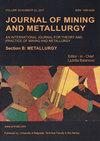Replacement of lime with industrial wastes in hot metal desulfurization mixtures
IF 1
4区 材料科学
Q3 METALLURGY & METALLURGICAL ENGINEERING
Journal of Mining and Metallurgy Section B-Metallurgy
Pub Date : 2022-01-01
DOI:10.2298/jmmb210407005s
引用次数: 0
Abstract
The steel production enhancement in recent decades has increased the solid waste generation in the steel plants. Due to the increase in the environmental policies stringency, efforts have been made to give them a more appropriate destination. In this context, the internal reuse of these materials is a solution often applied by the industry to reduce production costs and to decrease slag generation. Therefore, the aim of this research is to replace calcitic lime by limestone waste and KR slag in hot metal desulfurization, which are wastes from steel production. The KR slag is the waste generated by the desulfurization process in Kambara Reactor. Experimental desulfurization tests were carried out in a resistance furnace at a temperature of 1350?C, in an inert atmosphere with constant stirring of 500 rpm. Along with the tests, simulations were carried out with FactSage 7.0 software in order to obtain the phases present in each mixture at the working temperature and compare them with the practical results. It was found that the tricalcium silicate phase (3CaO?SiO2) was present in mixtures with lower desulfurization efficiency, which shows its kinetic limitation. The use of limestone waste proved to be more efficient than the use of KR slag.用工业废渣替代铁水脱硫混合物中的石灰
近几十年来,钢铁产量的提高增加了钢铁厂的固体废物产生量。由于环境政策的收紧,已经做出了努力,给他们一个更合适的目的地。在这种情况下,这些材料的内部再利用是工业界经常采用的一种解决方案,以降低生产成本和减少渣的产生。因此,本研究的目的是利用炼钢废渣——石灰石废渣和KR渣替代铁水脱硫中的钙质石灰。KR渣是Kambara反应器脱硫过程中产生的废弃物。实验脱硫试验在电阻炉中进行,温度为1350?C,在惰性气氛中,以500转/分的速度不断搅拌。在测试的同时,利用FactSage 7.0软件进行了模拟,以获得在工作温度下每种混合物中存在的相,并将其与实际结果进行比较。发现混合物中存在硅酸三钙相(3CaO?SiO2),脱硫效率较低,表明其动力学局限性。石灰石废料的利用比KR渣的利用更有效。
本文章由计算机程序翻译,如有差异,请以英文原文为准。
求助全文
约1分钟内获得全文
求助全文
来源期刊
CiteScore
2.00
自引率
40.00%
发文量
19
审稿时长
2 months
期刊介绍:
University of Belgrade, Technical Faculty in Bor, has been publishing the journal called Journal of Mining and Metallurgy since 1965 and in 1997 it was divided in two independent journals dealing with mining and metallurgy separately. Since 2009 Journal of Mining and Metallurgy, Section B: Metallurgy has been accepted in Science Citation Index Expanded.
Journal of Mining and Metallurgy, Section B: Metallurgy presents an international medium for the publication of contributions on original research which reflect the new progresses in theory and practice of metallurgy. The Journal covers the latest research in all aspects of metallurgy including hydrometallurgy, pyrometallurgy, electrometallurgy, transport phenomena, process control, solidification, mechanical working, solid state reactions, materials processing, surface treatment and relationships among processing, structure, and properties of materials.

 求助内容:
求助内容: 应助结果提醒方式:
应助结果提醒方式:


